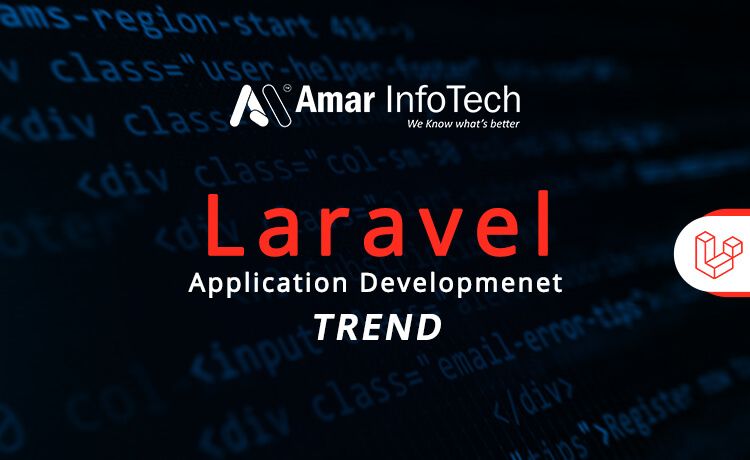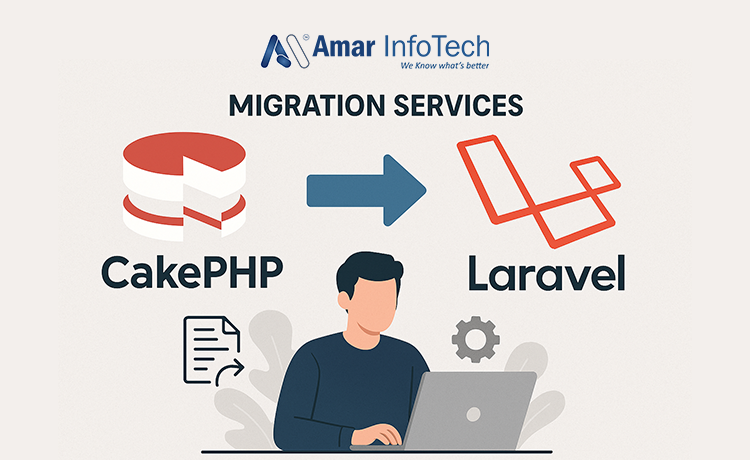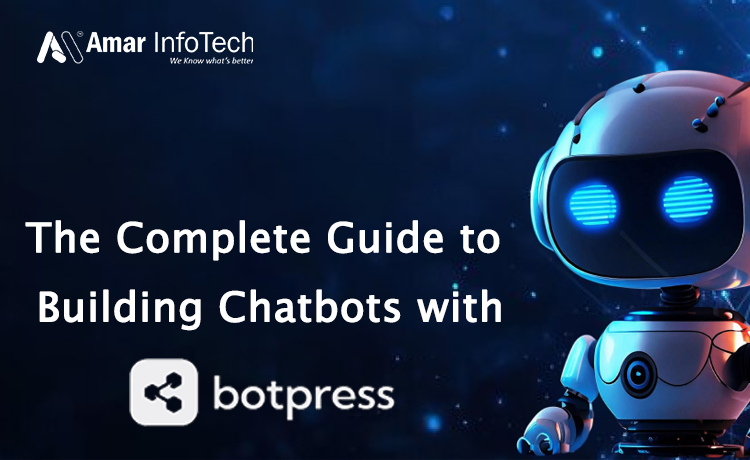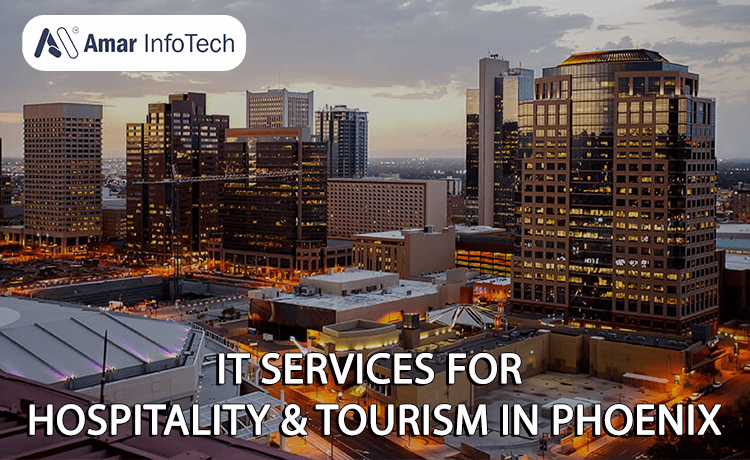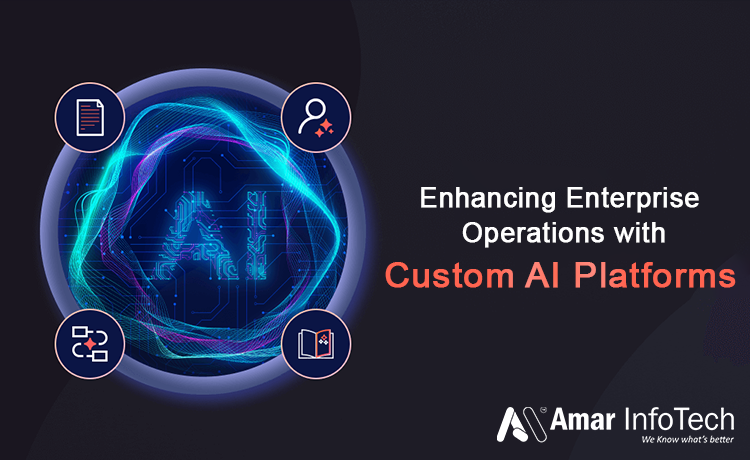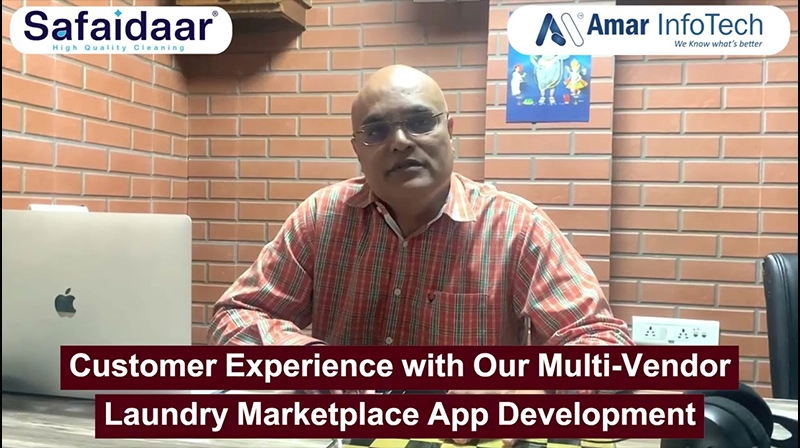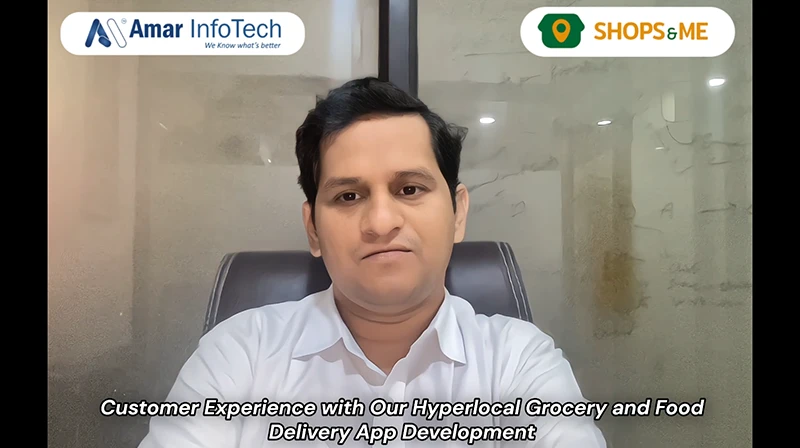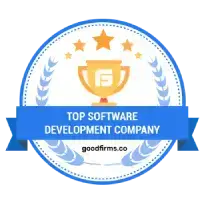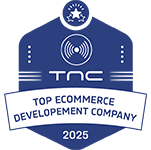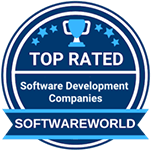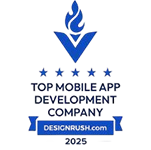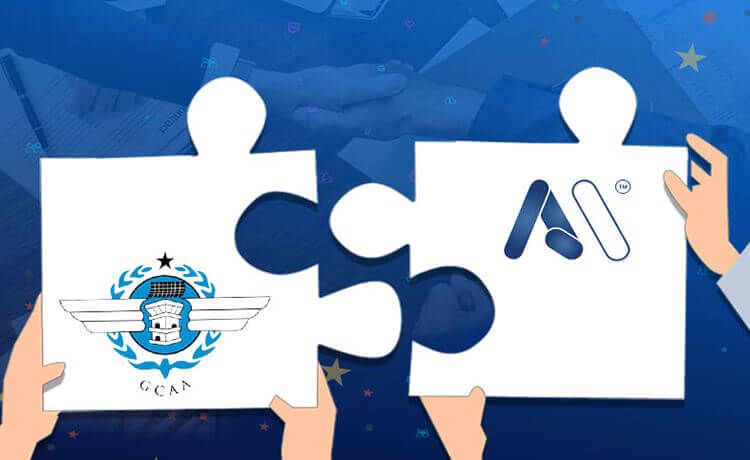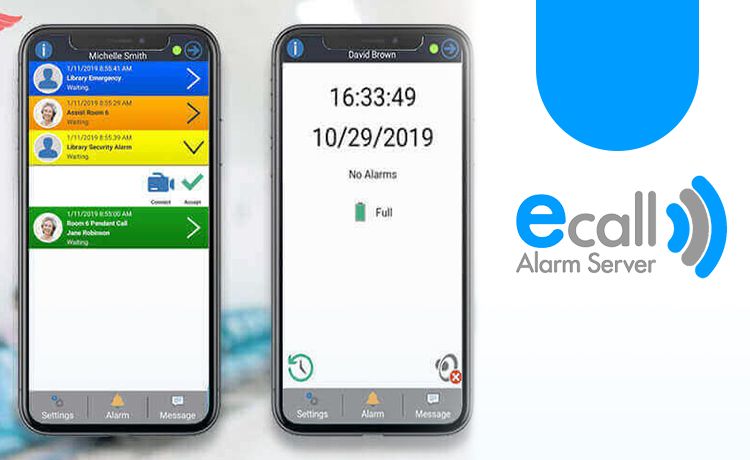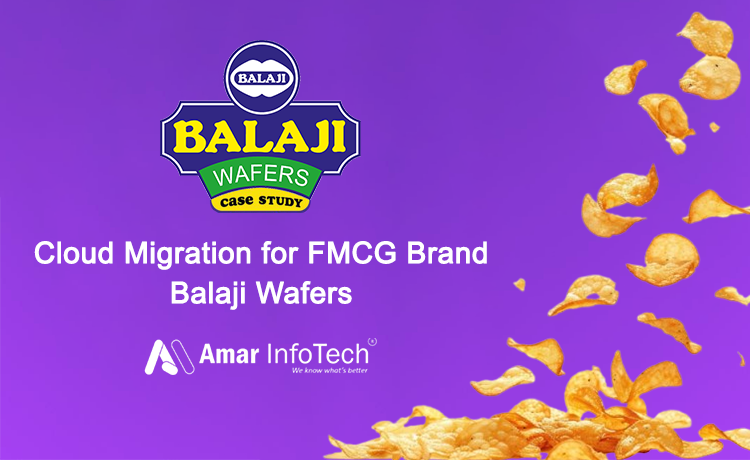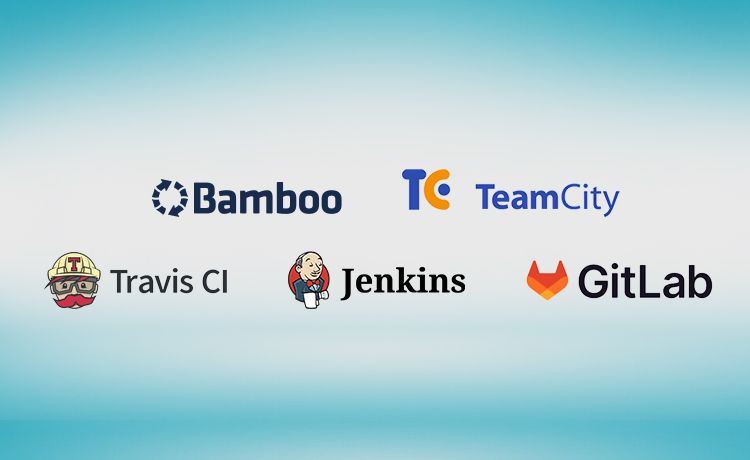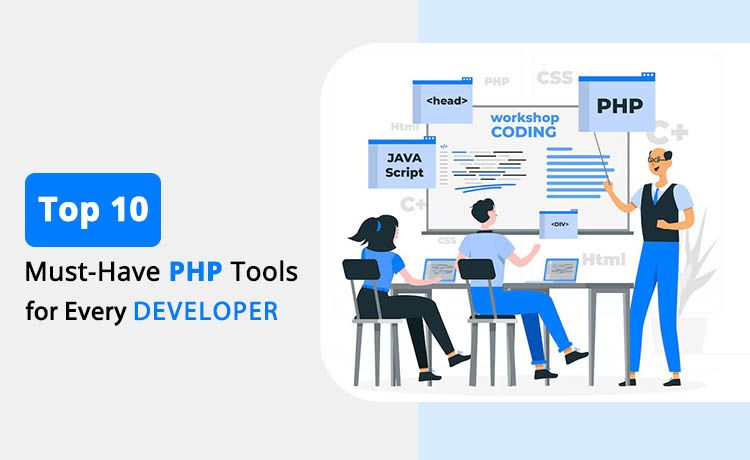Laravel is a popular PHP framework in 2025, utilized for web application development. Renowned for its elegant syntax, user-friendliness, and extensive libraries, Laravel has been steadily gaining traction among developers globally. Its popularity is anticipated to continue rising throughout 2025.
What is Laravel?
Laravel is an open-source PHP framework that provides developers with a wide range of tools for building custom web applications. Originally built on Symfony, another PHP-based framework, Laravel has evolved into its own entity, enabling developers to create full-stack applications with maximum efficiency.
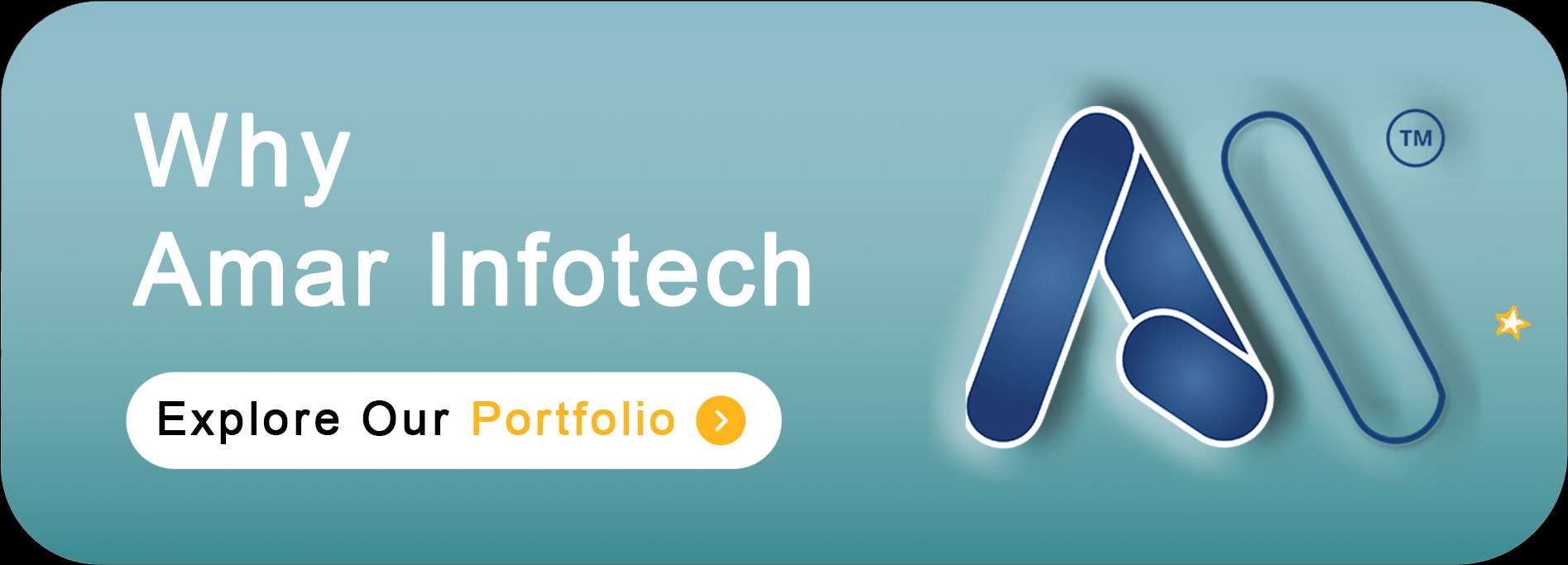
The primary goal of Laravel development is to enhance the accessibility of web applications. This is achieved through its expressive and elegant syntax, which empowers Laravel developers to write clean, testable, and maintainable code at a faster pace. Laravel's design patterns and best practices, along with its coding standards, are the keys to its success.
Amar InfoTech offers a range of development services that make it an attractive choice for businesses and organizations. Laravel development services can include everything from custom application development to API integration, as well as maintenance and support services.
Laravel's integration with other PHP libraries and data binding capabilities also make it a versatile choice for developers who need to work with a variety of tools and technologies. With all of these benefits, it's no wonder that Laravel has become one of the most popular PHP frameworks on the market today.
Furthermore, Laravel offers several benefits, such as convention over configuration, rapid development, powerful routing and validation, integration with other PHP libraries, and data binding. All of these features have made Laravel a highly sought-after PHP framework.
In this blog, we will explore the latest Laravel trends in 2025 and best practices for web development that can help you transform your Laravel-based websites and web applications.
Laravel has raised a $57M Series A in partnership with Accel
Laravel has raised a $57 million Series A investment, led by Accel, marking the first time the company has taken outside funding in its 13-year history. This funding will help Laravel expand its team and further support its open-source framework, which is widely used by companies like Apple, Zillow, and Pfizer. The investment will also fuel the development of Laravel Cloud, a new platform designed to simplify web app deployment, making it more affordable and accessible for developers.
Accel had pursued Laravel for over a year, drawn by its profitability and the strong community it has built. Laravel's founder, Taylor Otwell, intends to use this capital to enhance the developer experience, scale the company, and accelerate product development(SiliconANGLE)(Accel).
News Source : Laravel Blog
Taylor Otwell: The Visionary Behind Laravel's Success
In the world of web development, few names are as revered as Taylor Otwell. As the creator of Laravel, one of the most popular PHP frameworks, Otwell has not only transformed how developers build web applications but has also fostered a vibrant community that continues to push the boundaries of innovation. His story is one of passion, ingenuity, and relentless pursuit of simplicity in a complex digital world.
- The Genesis of Laravel
- Building a Framework for the Future
- Fostering a Global Community
- Beyond Laravel: Expanding the Ecosystem
- The Legacy of Taylor Otwell
In 2011, Taylor Otwell saw a gap in the tools available to PHP developers. Although there were several frameworks in existence, none offered the simplicity and elegance that he envisioned. Taylor believed that developers deserved a framework that was expressive, easy to use, and could help them create robust web applications quickly. Thus, Laravel was born.
From its early days, Laravel stood out for its clean syntax, intuitive structure, and developer-friendly features like Eloquent ORM and Blade templating engine. Taylor's vision was clear: to make PHP development enjoyable and accessible for everyone, from novice programmers to seasoned professionals.
Otwell’s approach to Laravel wasn’t just about coding; it was about building a framework with the future in mind. Each version of Laravel introduced groundbreaking features such as Laravel Forge, which simplified server management, and Laravel Nova, an elegant administration panel for managing data. These innovations, coupled with Laravel’s focus on modularity and extensibility, made it a go-to solution for developers working on everything from small personal projects to large-scale enterprise applications.
Taylor’s ability to anticipate the needs of the development community has been key to Laravel’s long-term success. He continuously adapts and evolves Laravel, integrating new technologies and practices while maintaining the simplicity that developers love.
One of Taylor’s greatest achievements is not just the framework itself but the thriving global community that surrounds Laravel. Through conferences like Laracon, extensive documentation, and countless online resources, Otwell has cultivated a welcoming and supportive environment for developers of all levels. This strong sense of community has fueled the framework’s growth, with thousands of contributors and users sharing their knowledge, building extensions, and creating solutions based on Laravel.
The success of Laravel is a testament to Otwell’s commitment to collaboration. He often acknowledges the contributions of others and has built a culture around Laravel that encourages sharing and learning.
While Laravel remains Taylor’s flagship achievement, his work doesn’t stop there. Over the years, he has expanded the Laravel ecosystem with products such as Laravel Vapor, a serverless deployment platform, and Laravel Cashier, a subscription billing integration. Each of these products enhances the Laravel experience, providing developers with powerful tools that further streamline their workflows.
Otwell’s focus on refining the developer experience extends to his podcasting, speaking engagements, and online interactions. He remains an active and approachable figure in the Laravel community, regularly engaging with users and developers on social media and at events.
Taylor Otwell’s legacy is one of empowering developers to build better, faster, and more efficient web applications. Laravel has become more than just a framework; it’s a movement that reflects Taylor’s core belief in making development both efficient and enjoyable. His dedication to innovation and community has ensured that Laravel will continue to thrive for years to come.
As Laravel continues to evolve, one thing is certain: Taylor Otwell’s visionary leadership will remain at the heart of its success, inspiring developers around the world to push the boundaries of what’s possible in web development.
Top Laravel Development Trends 2025 List
- 1) Microservices Architecture
- 2) Serverless Architecture
- 3) Real-time Applications
- 4) Cloud-Native Applications
- 5) Laravel Headless CMS
- 6) GraphQL API
- 7) Artificial Intelligence and Machine Learning
- 8) Progressive Web Apps
- 9) DevOps
- 10) Security and Privacy
- 11) Blockchain
- 12) Low-Code Development
- Conclusion
Why is Laravel development in demand?
Laravel development has become increasingly popular in recent years, and there are several reasons for its rising demand:
- Elegance and Simplicity:
- Strong Community Support:
- Security:
- Scalability:
- Modular Structure:
- Testing Capabilities:
Laravel has an elegant and simple syntax, which makes it easy to learn and use. It also provides developers with several pre-built functions and tools, allowing them to build web applications with speed and efficiency.
Laravel has a strong community of developers who contribute to its development, offer support, and create various open-source packages that can be used in Laravel projects. This community support ensures that Laravel is constantly evolving and improving.
Laravel has several built-in security features, such as password hashing, encryption, and CSRF protection, making it a secure choice for web application development.
Business owners opt to hire dedicated Laravel developers to leverage the Laravel framework's capabilities in promoting data protection, privacy, and security for their web applications. The framework provides several security features, such as password storage, user authentication, data encryption, and more.
Laravel is designed to handle large-scale applications, making it an ideal choice for businesses with long-term growth plans.
Laravel follows a modular structure, making it easy for developers to manage and organize their codebase. This modularity also allows for easy customization and extension of the framework.
Laravel has built-in testing capabilities that enable developers to write and run tests for their applications, ensuring that they are functioning correctly and free from bugs.
What is Laravel Volt?
Laravel Volt is a new front-end template that was introduced in Laravel 8.x. It is a modern, lightweight, and customizable template that provides a clean and elegant user interface for Laravel applications.
Volt is built using the latest web development technologies such as Tailwind CSS, Alpine.js, and Blade templates. It includes pre-built UI components such as forms, buttons, modals, and tables that can be easily customized to suit the needs of a Laravel project.
Volt is designed to work seamlessly with Laravel's authentication system, making it easy to integrate user authentication and authorization into Laravel applications. It also includes pre-built pages such as login, register, forgot password, and email verification pages that can be customized to match the branding of a Laravel application.
One of the main advantages of Volt is its simplicity and ease of use. It provides a clean and modern user interface that can be easily customized using Laravel's Blade templating engine. Developers can quickly build responsive web applications using Volt without having to worry about designing the user interface from scratch.
Laravel vs Volt | What are the differences?
Laravel is a PHP framework, while Volt is a compiled language. Laravel emphasizes convention over configuration, while Volt provides more explicit control over configuration. The choice between the two depends on project needs and development team preferences.
What is Laravel Folio?
Laravel Folio appears to be a package or library that provides page-based routing functionality for Laravel, similar to what Next.js provides for React applications
With Laravel Folio announcement by Taylor Otweel, especially developers, developers can define pages in a file-based format, and the package will automatically create routes based on the page structure.
Laravel Folio appears to be a useful package for developers looking to build page-based applications with Laravel, and it may be especially helpful for those with experience using Next.js or similar frameworks.
The Best Laravel Development Trends in 2025
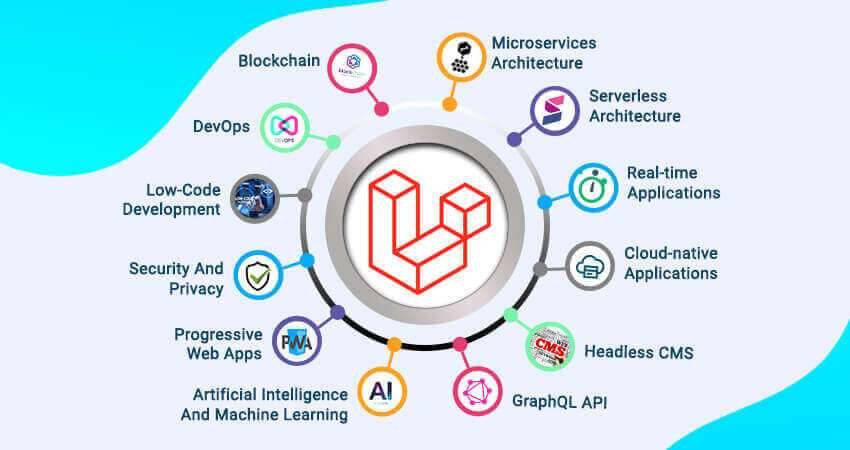
1) Microservices Architecture
Microservices architecture is expected to continue to gain popularity in 2025, as it allows developers to create highly scalable and resilient applications by breaking down the application into smaller, more manageable components.
Microservices architecture is a way of developing software systems that are made up of loosely coupled, independent services. Laravel, which is a widely used PHP framework, provides a range of functionalities and utilities that are suitable for establishing a microservices architecture.
Below are essential factors to keep in mind while executing a microservices architecture using Laravel:
- Break Down the Application into Smaller Services
- Use APIs for Communication
- Use a Service Registry
- Use a Message Broker for Asynchronous Communication
- Use a Containerization Platform
- Use a Monitoring Tool
The first step in implementing a microservices architecture is to break down the application into smaller services. Each service should be responsible for a specific business function or capability. Laravel provides a number of features, such as routing, controllers, and middleware, that can be used to create these services.
Microservices communicate with each other through APIs. Laravel offers a number of tools, such as the Guzzle HTTP client, that can be used to create and consume APIs. By using APIs, each service can be developed and deployed independently of the others.
In a microservices architecture, services need to be able to discover each other. A service registry, such as Consul or Eureka, can be used to keep track of the available services and their endpoints. Laravel provides integrations with both Consul and Eureka.
In some cases, services need to communicate with each other asynchronously. A message broker, such as RabbitMQ or Apache Kafka, can be used for this purpose. Laravel provides integrations with both RabbitMQ and Kafka.
Containerization platforms, such as Docker or Kubernetes, can be used to deploy and manage the microservices. Laravel provides integrations with both Docker and Kubernetes.
As the number of services in a microservices architecture grows, it can become difficult to monitor them all. A monitoring tool, such as New Relic or Datadog, can be used to keep track of the health and performance of the services. Laravel provides integrations with both New Relic and Datadog.
2) Laravel Serverless Architecture
Serverless architecture will continue to be a trending topic in 2025. Laravel developers can leverage serverless technology to reduce the complexity of application deployment and maintenance, thereby saving time and money.
Serverless architecture is a way of building and running applications and services without the need for servers. One can utilize Laravel, a well-known PHP framework, to develop serverless applications with the help of services like AWS Lambda or Google Cloud Functions.
Consider these essential factors when incorporating a serverless architecture in Laravel:
- Use a Function-as-a-Service Provider
- Break down the Application into Functions
- Use Event-Driven Architecture
- Use a Database-as-a-Service Provider
- Use a Storage-as-a-Service Provider
- Use a Monitoring Tool
The first step in implementing a serverless architecture is to choose a function-as-a-service provider, such as AWS Lambda or Google Cloud Functions. Laravel provides integrations with both of these providers, as well as with other providers such as Azure Functions.
In a serverless architecture, applications are broken down into smaller functions. Each function should be responsible for a specific business function or capability. Laravel provides a number of features, such as routing and controllers, that can be used to create these functions.
In a serverless architecture, functions are triggered by events. Laravel provides integrations with a number of event-driven services, such as AWS S3 and Google Cloud Pub/Sub, that can be used to trigger functions.
In a serverless architecture, databases are typically managed by a database-as-a-service provider, such as AWS DynamoDB or Google Cloud Firestore. Laravel provides integrations with both of these providers, as well as with other providers such as Azure Cosmos DB.
In a serverless architecture, storage is typically managed by a storage-as-a-service provider, such as AWS S3 or Google Cloud Storage. Laravel provides integrations with both of these providers, as well as with other providers such as Azure Blob Storage.
As with any application, it's important to monitor the health and performance of serverless applications. A monitoring tool, such as AWS CloudWatch or Google Cloud Monitoring, can be used to keep track of function invocations, errors, and other metrics. Laravel provides integrations with both of these tools, as well as with other tools such as New Relic and Datadog.
Laravel Serverless Deployment Platform - Laravel Vapor
Laravel Vapor is a deployment platform designed specifically for serverless Laravel applications. Using Vapor, developers can easily deploy their applications to AWS Lambda and manage their infrastructure and scaling requirements from a single dashboard./
3) Real-time Applications
Real-time applications will become more prevalent in 2025, and Laravel's support for websockets and event broadcasting will allow developers to create responsive and engaging real-time applications.
Real-time applications are those that require immediate and instantaneous updates to be visible to the user. Several features and tools provided by Laravel, a prevalent PHP framework, can be utilized to create real-time applications.
Consider the following important aspects when developing real-time applications in Laravel:
- Use a Real-Time Communication Protocol
- Use a Real-Time Message Broker
- Use a Real-Time Event Broadcasting System
- Use a Real-Time Notification System
- Use a Real-Time Data Synchronization System
- Use a Real-Time Monitoring Tool
The first step in implementing real-time applications is to choose a real-time communication protocol, such as WebSockets or Server-Sent Events (SSE). Laravel provides integrations with both of these protocols, as well as with other protocols such as Pusher and Socket.io.
In a real-time application, messages are sent between the client and the server in real-time. A real-time message broker, such as Redis or RabbitMQ, can be used to manage these messages. Laravel provides integrations with both of these message brokers, as well as with other brokers such as Kafka.
In a real-time application, events are broadcasted to clients in real-time. Laravel provides an event broadcasting system that can be used to broadcast events to clients using WebSockets or SSE.
In a real-time application, notifications are sent to clients in real-time. Laravel provides a notification system that can be used to send notifications to clients using WebSockets or SSE.
In a real-time application, data needs to be synchronized between the client and the server in real-time. Laravel provides a real-time data synchronization system, called Laravel Echo, that can be used to synchronize data between the client and the server using WebSockets or SSE.
As with any application, it's important to monitor the health and performance of real-time applications. A real-time monitoring tool, such as Laravel Horizon or Telescope, can be used to keep track of real-time events and metrics.
4) Cloud-Native Applications
Cloud-native applications are expected to be a key trend in 2025. Laravel developers can leverage cloud services such as AWS, Azure, and Google Cloud to build highly scalable and resilient applications.
Cloud-native applications are those that are designed and developed to run on cloud infrastructure, taking full advantage of the scalability, flexibility, and reliability that cloud platforms offer. Laravel, which is a widely used PHP framework, is suitable for creating cloud-native applications that can operate on different cloud platforms.
Below are a few essential factors to contemplate while implementing cloud-native applications utilizing Laravel:
- Use a Containerization Platform
- Use a Cloud Platform
- Use a Cloud Database
- Use a Cloud Storage Service
- Use a Serverless Computing Service
- Use a Monitoring Tool
The first step in implementing cloud-native applications is to use a containerization platform, such as Docker or Kubernetes. Laravel provides integrations with both of these platforms, as well as with other platforms such as Rancher.
In a cloud-native application, the application is deployed and run on a cloud platform, such as Amazon Web Services (AWS), Google Cloud Platform (GCP), or Microsoft Azure. Laravel provides integrations with all of these platforms, as well as with other platforms such as DigitalOcean.
In a cloud-native application, the database is typically managed by a cloud database service, such as AWS RDS, GCP Cloud SQL, or Azure SQL. Laravel provides integrations with all of these services, as well as with other services such as DigitalOcean Managed Databases.
In a cloud-native application, storage is typically managed by a cloud storage service, such as AWS S3, GCP Cloud Storage, or Azure Blob Storage. Laravel provides integrations with all of these services, as well as with other services such as DigitalOcean Spaces.
In a cloud-native application, serverless computing services, such as AWS Lambda or GCP Cloud Functions, can be used to run application code in a highly scalable and cost-effective manner. Laravel provides integrations with both of these services, as well as with other services such as Azure Functions.
As with any application, it's important to monitor the health and performance of cloud-native applications. A monitoring tool, such as AWS CloudWatch or GCP Stackdriver, can be used to keep track of application metrics and events. Laravel provides integrations with both of these tools, as well as with other tools such as New Relic and Datadog.
5) Laravel headless CMS Open-source
Laravel Headless CMS architecture is gaining more popularity as it allows developers to separate the content from the presentation layer, thereby providing more flexibility and agility in building applications.
Laravel has several headless CMS options such as Strapi, Directus, and Contentful, which will enable developers to build dynamic and flexible applications.
Laravel Headless Ecommerce
With the rise of ecommerce, Laravel developers are looking for headless CMS Ecommerce solutions that can manage product catalogs and customer data without dictating the front-end experience.
Laravel Forge offers a seamless deployment process for headless ecommerce CMS, making it easy for developers to get up and running quickly.
Here are List Of Popular open-source headless CMS options for Laravel:
- Strapi: The Best Headless CMS for Laravel
- Directus
- Cockpit
- Flamelink.io - A headless Firebase CMS
- Hygraph: The Next Generation GraphQL Content Platform
Strapi is a powerful open-source headless CMS that offers a user-friendly interface and customizable API endpoints.
Strapi allows developers to create and manage content in a structured way and delivers content through APIs, making it an ideal choice for Laravel developers. Strapi has a dedicated Laravel integration, making it easy to integrate Strapi with Laravel projects.
Strapi is also highly customizable, with options to add custom code and plugins to meet specific project needs.
Directus is a flexible, open-source headless CMS that allows developers to create custom database schemas and API endpoints. It has a user-friendly interface and offers a range of integrations with other tools.
Cockpit is a lightweight, open-source headless CMS that offers a simple and intuitive interface. It supports custom fields, user roles, and permissions, making it a good option for managing content for smaller projects.
Flamelink is a cloud-based headless CMS that offers a visual interface for managing content. It has integrations with popular front-end frameworks like React, Vue, and Angular, and offers a range of content management features like localization and versioning.
GraphCMS is now Hygraph is a cloud-based headless CMS that offers a GraphQL API for managing and delivering content. It has a range of features like schema validation and content localization, and offers integrations with popular front-end frameworks like React and Angular.
These open-source headless CMS options provide Laravel developers with a range of options for building custom front-end experiences without the constraints of a traditional CMS.
6) GraphQL API
GraphQL is a query language for APIs that allows developers to retrieve only the data they need, thereby reducing network overhead and improving application performance. Laravel developers can leverage GraphQL to build efficient and flexible APIs.
GraphQL is a query language for APIs that was developed by Facebook. It provides a flexible, efficient, and powerful approach to querying data from an API, and it's becoming increasingly popular in the developer community. Laravel is a renowned PHP framework that empowers developers to build GraphQL APIs capable of efficiently managing intricate queries and mutations.
When incorporating a GraphQL API in Laravel, it is essential to take into account the following pivotal aspects:
- Use a GraphQL Schema
- Use a Resolver
- Use a Data Source
- Use a Caching Mechanism
- Use a Validation System
- Use a Security Mechanism
The first step in implementing a GraphQL API in Laravel is to define a GraphQL schema that describes the types of data that the API can return. Laravel provides a package called GraphQL that makes it easy to define and manage a GraphQL schema.
In a GraphQL API, a resolver is a function that is responsible for resolving a query or mutation to a specific value. Laravel provides an easy-to-use resolver system that allows you to define resolvers for each field in your GraphQL schema.
In a GraphQL API, data is typically retrieved from a data source, such as a database or an external API. Laravel provides integrations with different data sources, such as MySQL and MongoDB, as well as with other APIs and services.
In a GraphQL API, caching can be used to improve performance by reducing the number of requests to the data source. Laravel provides integrations with different caching mechanisms, such as Redis and Memcached, that can be used to cache data in a GraphQL API.
In a GraphQL API, it's important to validate queries and mutations to ensure that they are well-formed and that they don't expose sensitive data. Laravel provides a built-in validation system that can be used to validate GraphQL queries and mutations.
In a GraphQL API, security is critical to protect against attacks and unauthorized access. Laravel provides integrations with different security mechanisms, such as JWT and OAuth, that can be used to secure a GraphQL API.
7) Artificial Intelligence and Machine Learning
Laravel developers can leverage AI and machine learning technologies to build intelligent applications that can learn and adapt to user behavior and preferences.
Artificial Intelligence (AI) and Machine Learning (ML) are rapidly growing fields that are transforming the way businesses operate. By leveraging Laravel, a widely-used PHP framework, it is possible to create AI and ML applications that enable data analysis, predictive modeling, and task automation.
When integrating AI and ML capabilities into Laravel, it is crucial to keep in mind the following essential considerations:
- Use a Data Pipeline
- Use a Machine Learning Library
- Use a Prediction System
- Use an Automation System
- Use a Natural Language Processing (NLP) Library
- Use a Computer Vision Library
The first step in implementing AI and ML in Laravel is to set up a data pipeline that can collect, clean, and process data. Laravel provides integrations with different databases, such as MySQL and PostgreSQL, as well as with other data processing tools like Apache Spark and Kafka.
In a machine learning application, a machine learning library is used to build and train models. Laravel provides integrations with different machine learning libraries, such as TensorFlow and Scikit-learn, that can be used to build and train models.
In a machine learning application, a prediction system is used to make predictions based on the trained model. Laravel provides an easy-to-use prediction system that allows you to make predictions based on the trained model.
In an AI application, an automation system is used to automate tasks based on the analyzed data. Laravel provides an easy-to-use automation system that allows you to automate tasks based on the analyzed data.
In an AI application, an NLP library is used to analyze and process text data. Laravel provides integrations with different NLP libraries, such as SpaCy and NLTK, that can be used to analyze and process text data.
In an AI application, a computer vision library is used to analyze and process image and video data. Laravel provides integrations with different computer vision libraries, such as OpenCV and TensorFlow, that can be used to analyze and process image and video data.
8) Progressive Web Apps
Progressive Web Apps (PWAs) provide a mobile-like experience to users while offering the convenience of a web application. Laravel developers can leverage PWA technology to build highly responsive and engaging web applications.
Progressive Web Apps (PWAs) are web applications that provide a mobile-like experience to users while leveraging the capabilities of modern web browsers. Laravel, a widely used PHP framework, offers the ability to build progressive web applications (PWAs) that allow offline usage and can be installed onto users' devices.
When integrating PWAs with Laravel, it's important to keep in mind the following key factors:
- Use a Service Worker
- Use a Web App Manifest
- Use Responsive Design
- Use Push Notifications
- Use a Caching Mechanism
- Use HTTPS
The first step in implementing a PWA in Laravel is to use a service worker, which is a script that runs in the background and can cache content, handle network requests, and provide offline functionality. Laravel provides integrations with different service worker libraries, such as Workbox, that can be used to implement a service worker.
In a PWA, a web app manifest is a JSON file that provides metadata about the app, such as its name, icon, and start URL. Laravel provides an easy-to-use manifest generator that allows you to generate a web app manifest for your PWA.
In a PWA, responsive design is critical to provide a mobile-like experience to users. Laravel provides integrations with different front-end frameworks, such as Bootstrap and Tailwind, that can be used to implement responsive design.
In a PWA, push notifications can be used to keep users engaged and informed. Laravel provides integrations with different push notification services, such as Firebase Cloud Messaging and Pusher, that can be used to implement push notifications.
In a PWA, caching can be used to improve performance and provide offline functionality. Laravel provides integrations with different caching mechanisms, such as Redis and Memcached, that can be used to cache content in a PWA.
In a PWA, HTTPS is critical to ensure that the app is secure and that sensitive data is not exposed. Laravel provides integrations with different SSL providers, such as Let's Encrypt and Cloudflare, that can be used to implement HTTPS.
9) DevOps
DevOps practices such as continuous integration and continuous deployment are becoming increasingly popular in 2025. Laravel developers can leverage DevOps practices to streamline the development, testing, and deployment of their applications.
DevOps is a set of practices that combine software development and IT operations to improve the speed and quality of software delivery. Laravel, a widely adopted PHP framework, supports the creation of applications that seamlessly integrate into a DevOps workflow.
When incorporating DevOps practices into Laravel, it's important to keep in mind the following key factors:
- Use Version Control
- Use Automated Testing
- Use Continuous Integration
- Use Containerization
- Use Infrastructure As Code
- Use Monitoring And Logging
The first step in implementing DevOps in Laravel is to use version control, such as Git, to manage changes to your codebase. Version control makes it easy to track changes, collaborate with others, and roll back changes if necessary.
In a DevOps workflow, automated testing is critical to ensure that your code is stable and reliable. Laravel provides integrations with different testing frameworks, such as PHPUnit and Laravel Dusk, that can be used to automate testing.
In a DevOps workflow, continuous integration is used to automatically build, test, and deploy code changes. Laravel provides integrations with different continuous integration tools, such as Jenkins and Travis CI, that can be used to implement continuous integration.
In a DevOps workflow, containerization is used to package an application and its dependencies into a single container that can be deployed consistently across different environments. Laravel provides integrations with different containerization tools, such as Docker and Kubernetes, that can be used to implement containerization.
In a DevOps workflow, infrastructure as code is used to manage infrastructure using code, rather than manual processes. Laravel provides integrations with different infrastructure as code tools, such as Terraform and Ansible, that can be used to implement infrastructure as code.
In a DevOps workflow, monitoring and logging are used to track the performance and availability of an application. Laravel provides integrations with different monitoring and logging tools, such as New Relic and Loggly, that can be used to implement monitoring and logging.
10) Security and Privacy
With the increasing focus on data privacy and security, Laravel developers will need to prioritize building secure and resilient applications. Laravel's built-in security features such as password hashing, encryption, and CSRF protection can help developers build secure applications.
Security and privacy are critical considerations when developing web applications, and Laravel, a widely used PHP framework, offers a range of capabilities and recommended practices aimed at securing and safeguarding the privacy of applications.
Here are some key points to consider when implementing security and privacy in Laravel:
- Use Encryption
- Use Authentication
- Use Authorization
- Use Validation
- Use Secure Coding Practices
- Use HTTPS
- Use Logging and Monitoring
Laravel provides built-in encryption capabilities using the OpenSSL library. Encrypting sensitive data, such as user passwords and credit card information, helps protect against data breaches.
Laravel provides a built-in authentication system that supports different authentication providers, such as email and password, social media accounts, and multi-factor authentication. Implementing authentication helps ensure that only authorized users can access protected resources.
Laravel provides a robust authorization system that allows you to define different roles and permissions for users. Implementing authorization helps ensure that users can only perform actions that they are authorized to perform.
Laravel provides a built-in validation system that allows you to validate user input to ensure that it meets certain criteria. Implementing validation helps prevent injection attacks and other security vulnerabilities.
Laravel provides several security features that help prevent common security vulnerabilities, such as cross-site scripting (XSS), cross-site request forgery (CSRF), and SQL injection. Following secure coding practices, such as input sanitization, helps reduce the risk of security vulnerabilities.
Laravel provides built-in support for HTTPS, which encrypts data in transit and helps protect against interception and tampering. Implementing HTTPS is critical for protecting user privacy and data.
Laravel provides logging and monitoring capabilities that allow you to track and investigate suspicious activity, such as failed login attempts and unusual patterns of behavior. Implementing logging and monitoring helps identify security incidents and respond to them quickly.
11) Blockchain
Laravel developers can leverage blockchain technology to build secure and decentralized applications that can provide transparency and immutability.
Blockchain is a distributed ledger technology that provides a secure, transparent, and tamper-proof way of recording transactions. The utilization of Laravel, a well-known PHP framework, is feasible in the development of applications based on blockchain technology.
Below are some essential factors to take into account while integrating blockchain technology in Laravel:
- Use a Blockchain Platform
- Use Smart Contracts
- Use a Blockchain API
- Use Cryptography
- Use Consensus Mechanisms
- Use Private Keys
There are several blockchain platforms available, such as Ethereum, Hyperledger, and Corda, that can be used to develop blockchain applications. Laravel provides integrations with different blockchain platforms, which can be used to implement blockchain-based applications.
Smart contracts are self-executing contracts that are programmed to automatically execute when certain conditions are met. Laravel provides integrations with different smart contract platforms, such as Solidity and Chaincode, that can be used to implement smart contracts.
Laravel provides integrations with different blockchain APIs, such as BlockCypher and Bitcore, that can be used to interact with blockchain networks. Using a blockchain API makes it easier to integrate blockchain functionality into your application.
Cryptography is a key component of blockchain technology, and Laravel provides built-in cryptography capabilities using the OpenSSL library. Cryptography is used to secure data in transit and at rest, and to verify the integrity of transactions.
Consensus mechanisms are used in blockchain networks to ensure that transactions are valid and to prevent fraud. Laravel provides integrations with different consensus mechanisms, such as Proof of Work and Proof of Stake, that can be used to implement consensus mechanisms in your blockchain-based application.
Private keys are used in blockchain networks to authenticate users and to sign transactions. Laravel provides built-in support for generating and managing private keys, which can be used to secure your blockchain-based application.
12) Low-Code Development
Low-code development platforms are gaining popularity as they allow developers to build applications quickly and efficiently without writing extensive code. Laravel developers can leverage low-code development platforms to build applications faster and more efficiently.
Low-code development is a software development approach that uses visual interfaces and drag-and-drop tools to create applications quickly and with minimal coding. Laravel, a popular PHP framework, can be used to develop low-code applications.
Here are some key points to consider when implementing low-code development in Laravel:
- Use Visual Editors
- Use Code Generators
- Use Pre-Built Components
- Use Templates
- Use APIs
Laravel provides integrations with different visual editors, such as Nova and Backpack, that can be used to create database tables, manage relationships, and create CRUD (Create, Read, Update, Delete) interfaces. Using visual editors can help you create applications quickly and with minimal coding.
Laravel provides code generators, such as Artisan, that can be used to generate boilerplate code for different application components, such as controllers, models, and migrations. Using code generators can help you create applications quickly and with minimal coding.
Laravel provides integrations with different pre-built components, such as Laravel UI and Laravel Jetstream, that can be used to add functionality to your application quickly and with minimal coding. Using pre-built components can help you create applications quickly and with minimal coding.
Laravel provides integrations with different templates, such as Blade and Twig, that can be used to create application interfaces quickly and with minimal coding. Using templates can help you create applications quickly and with minimal coding.
Laravel provides integrations with different APIs, such as RESTful APIs, that can be used to integrate your application with other applications quickly and with minimal coding. Using APIs can help you create applications quickly and with minimal coding.
Conclusion
Overall, the combination of these features has made Laravel a popular choice among developers for web application development. Its ease of use, security features, scalability, and strong community support make it a reliable and efficient framework for building custom web applications.
